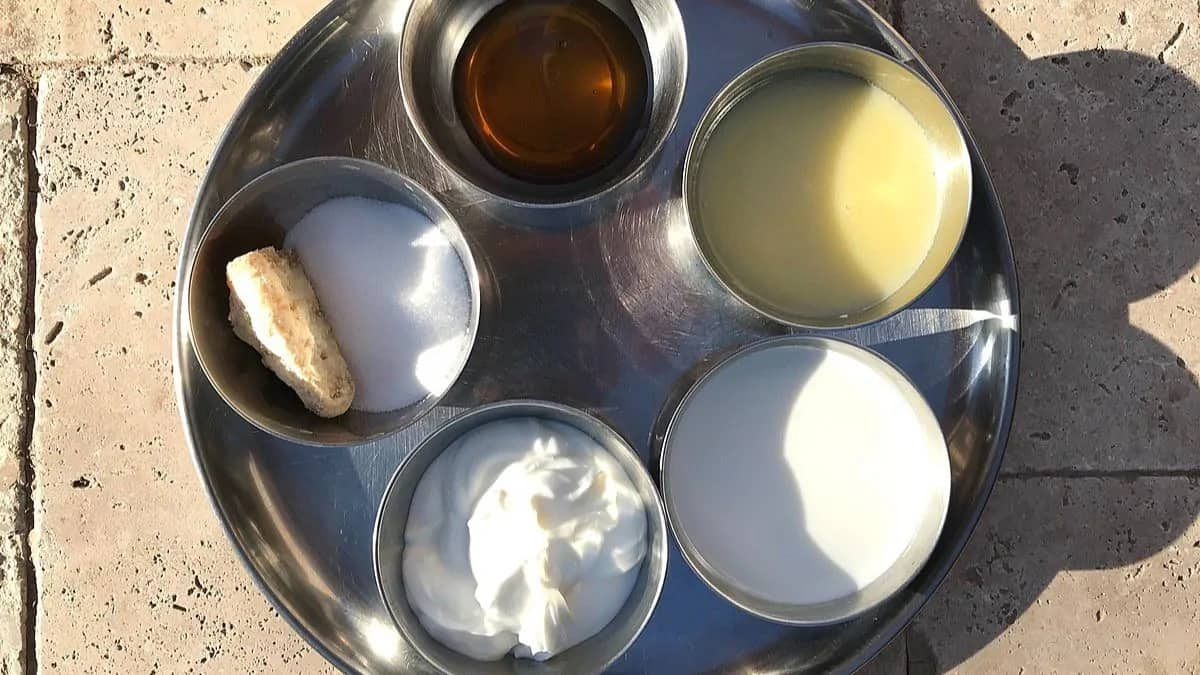
In Hindu worship, offering sacred foods and liquids to the deity forms a core part of ritual practice. Temple drinks have spiritual purpose. Devotees accept them as prasad after pujas or ceremonies. Among these sacred beverages, Panchamrit, Panakam and Charnamrit are widely known. Each of them has a distinct identity, though some ingredients or methods overlap. These drinks are not merely symbolic. They also reflect ancient concepts of purity, nourishment and community. Understanding their recipes offers insight into India’s ritual traditions.
Panchamrit
The word Panchamrit (also spelled Panchamrut) comes from Sanskrit: pancha means five and amrit means nectar or immortal drink. Sacred texts and ritual manuals describe five core ingredients for Panchamrit. These are cow’s milk, curd (yoghurt), honey, sugar (or rock sugar / candy sugar / mishri), and ghee (clarified butter). Each component carries symbolic importance. Milk stands for purity. Curd offers strength and sustenance. Honey brings sweetness of speech and unity. Sugar symbolises bliss. Ghee represents knowledge. 
Ritually, Panchamrit is used during abhisheka (temple bathing of deity idols), during pujas, festivals like Janmashtami, Ganesh Chaturthi, Satyanarayan Puja and other ceremonies. After offering, the drink is distributed among devotees. 
A basic recipe for Panchamrit proceeds as follows. Use pure cow’s milk that has cooled to room temperature. Add fresh curd. Stir gently. Then add honey, sugar or rock candy, and ghee. Mix all ingredients carefully until they combine. Optionally add holy basil (tulsi) leaves. Some households include Ganga jal (water from the Ganges) for its ritual purity. 
Measurement proportions vary by region. One common ratio (from north India) uses half a cup milk, two tablespoons curd, one tablespoon honey, a little ghee and sugar to taste.  Freshness matters. Panchamrit is best consumed soon after preparation. It is stored only briefly if needed. 
Panakam
Panakam (also called Panaka or Panagam in various South Indian languages) means “sweet drink” in Sanskrit. This drink is associated especially with Rama Navami festival because of its cooling properties. Temples in South India distribute Panakam to devotees in summer. 
Typical ingredients for Panakam are jaggery, water, cardamom, black pepper or ground pepper, and sometimes dry ginger. Lemon juice or fresh ginger may also be added in some versions.
To prepare Panakam, dissolve jaggery in warm or lukewarm water. Strain any impurities. Add crushed cardamom, pepper and optional ginger. Mix well. Some recipes finish with a squeeze of lemon. Chill or serve at moderate temperature. 
Charnamrit
The term Charnamrit combines charan meaning feet (or lotus feet in devotional context) and amrit meaning nectar. It refers to the water or liquid collected after the deity bathing ritual (abhisheka), or prepared similarly to Panchamrit and offered to devotees as sacred nectar. 
In many places Panchamrit and Charnamrit are used interchangeably. Some temples call the drink Charnamrit if it includes the water used during deity washing. Some regional practices add dry fruits, nuts, makhana (fox nuts), coconut, etc., to the basic five ingredients. 
A recipe for Charnamrit often mirrors that of Panchamrit with added optional ingredients. Use milk and fresh curd as base. Then add honey, sugar (or mishri / rock candy), and ghee. To this base add chopped nuts (almond, cashew), raisins, makhana or fox nuts, dry coconut slices, and cardamom powder. Add holy basil leaves. Optionally add Ganga jal. 
Mix gently. Use clean, non-reactive vessels and do not over-whisk. Serve in small portions as prasad. Many households refrigerate briefly before offering. Consume within hours because dairy begins to sour. 
Health, Regional Variations And Ritual Aspects
Each of these drinks fulfills multiple roles. They provide nourishment after fasting or rituals. Ingredients like curd and milk supply protein and good bacteria. Honey and jaggery provide energy. Ghee adds fat-soluble vitamins. Some of the optional ingredients (tulsi, nuts) bring anti-oxidants and micronutrients. Ayurvedic texts associate Panchamrit with health benefits. 
Regional variation is commonly observed. In Tamil Nadu, “Panchamirtham” includes banana, jaggery, dry fruits, tender coconut water. In Kerala some add fresh coconut or tender coconut water. In some areas sugar replaces jaggery. Some temple traditions avoid certain optional items depending on deity or local custom. 
Ritual aspects also matter. Use of clean utensils, purity of ingredients, hand washing before preparation, offering first to deity, then distributing prasad. Some temples use silver or bronze vessels. Some include Ganga jal for purification. These practices emphasise devotion and sacredness.